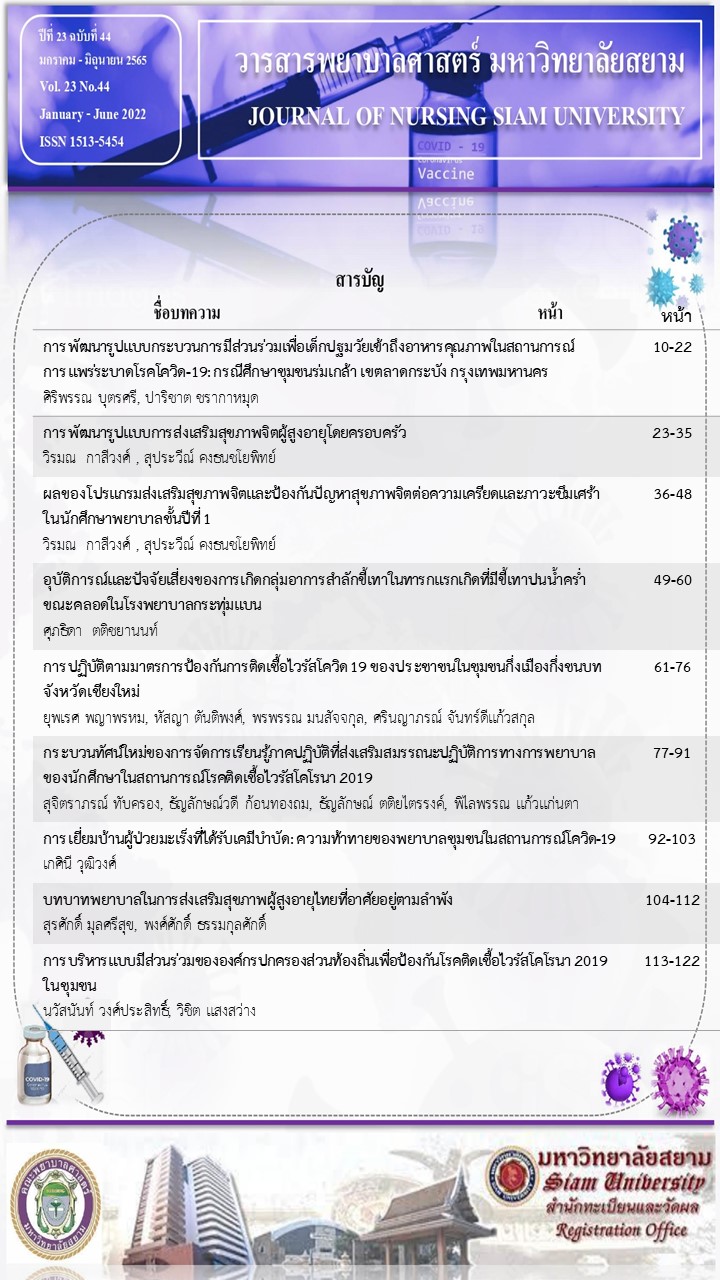กระบวนทัศน์ใหม่ของการจัดการเรียนรู้ภาคปฏิบัติที่ส่งเสริมสมรรถนะปฏิบัติการ ทางการพยาบาลของนักศึกษาในสถานการณ์โรคติดเชื้อไวรัสโคโรนา 2019
คำสำคัญ:
การศึกษาทางการพยาบาล , ปฏิบัติการพยาบาล , นักศึกษาพยาบาล , สถานการณ์โรคติดเชื้อไวรัสโคโรนา 2019บทคัดย่อ
ความพลิกผันทางระบบสุขภาพและสังคมโลกในช่วงที่มีการระบาดของโรคติดเชื้อไวรัสโคโรนา 2019 หลายระลอกในเวลา 2 ปีที่ผ่านมานั้น ส่งผลกระทบต่อประเทศไทยและทั่วโลก ในมิติของการศึกษาพยาบาลก็ได้รับผลกระทบเช่นกัน การเรียนการสอนรวมทั้งการฝึกปฏิบัติในหอผู้ป่วยของนักศึกษาพยาบาลเกิดการหยุดชะงัก ชะลอตัว เนื่องจากความจำเป็นในการป้องกันการแพร่ระบาดของเชื้อไวรัสโคโรนา 2019 สถานพยาบาลที่เป็นแหล่งฝึกปฏิบัติของนักศึกษาพยาบาลเองก็ได้มีการปรับตัวในการรับผิดชอบดูแลผู้ป่วยติดเชื้อไวรัสโคโรนา 2019 ซึ่งมีจำนวนมากอย่างที่ไม่เคยเป็นมาก่อนและยังกลายเป็นสถานที่ที่มีความเสี่ยงสูงในการฝึกปฏิบัติสำหรับนักศึกษา ขณะที่นักศึกษาพยาบาลเองนั้นยังไม่มีความรู้และทักษะและความชำนาญอย่างเพียงพอในการรับมือและป้องกันตัวเองในสถานการณ์นี้ไม่ว่าจะเป็นการดูแลตนเองหรือผู้ป่วย ทั้งนี้สถาบันการศึกษาพยาบาลทุกแห่งจึงได้มีการปรับกระบวนทัศน์ในการจัดการเรียนการสอนโดยใช้แพลตฟอร์มต่าง ๆ บนเครือข่ายอินเทอร์เน็ตที่สามารถออกแบบการเรียนการสอนได้อย่างหลากหลายรูปแบบ โดยเฉพาะในวิชาปฏิบัติที่นักศึกษาจะต้องนำความรู้ทางทฤษฎีไปประยุกต์ใช้ในการฝึกปฏิบัติจนผู้เรียนเกิดสมรรถนะที่พึงประสงค์ตามต้องการ ภายใต้ข้อจำกัดจากสถานการณ์ดังกล่าวจึงนับได้ว่าเป็นโอกาสและความท้าทายของความร่วมมือในการขับเคลื่อนการจัดการเรียนการสอนทั้งในระดับสถาบันและระดับเครือข่ายที่จะช่วยกันดำรงไว้ซึ่งพันธกิจการผลิตพยาบาลให้มีสมรรถนะทางวิชาชีพที่บรรลุตามข้อกำหนดของสภาการพยาบาลและสนองตอบความคาดหวังของสังคมและประชาชนผู้รับบริการ บทความวิชาการนี้จึงมีวัตถุประสงค์ที่จะนำเสนอวรรณกรรมที่เกี่ยวข้องกับกระบวนทัศน์ใหม่ในการจัดการศึกษาพยาบาล ได้แก่ การเรียนการสอนในคลินิกที่ตอบสนองสมรรถนะด้านปฏิบัติการพยาบาลและผดุงครรภ์ การจัดการเรียนรู้แบบผสมผสาน (Blended Learning)การประเมินผลการเรียนรู้แบบผสมผสาน และบทสรุปที่ขยายผลไปยังสภาวิชาชีพสถาบันการศึกษาพยาบาล อาจารย์พยาบาลและผู้ใช้บัณฑิต อันจะเป็นประโยชน์ในการปรับใช้ พัฒนาและต่อยอดจนไปถึงนวัตกรรมการเรียนการสอนในสถานการณ์วิกฤตที่ไม่คาดคิดต่อไปได้ในอนาคต
เอกสารอ้างอิง
กรมควบคุมโรค กระทรวงสาธารณสุข. (2564). 4 มาตรการเปิดประเทศ V-U-C-A. สืบค้น เมื่อ 9 มกราคม 2565 จาก https://ddc.moph.go.th/uploads/publish/1197620211123031938.pdf
ข้อบังคับสภาการพยาบาลว่าด้วยการให้ความเห็นชอบหลักสูตร การศึกษาวิชาชีพการพยาบาลและการ ผดุงครรภ์ระดับวิชาชีพ พ.ศ. ๒๕๖๓. (2563, 1 ธันวาคม). ราชกิจจานุเบกษา. เล่ม 137
ชัชวาล วงค์สารี (2558). การสอนบนคลินิกในรายวิชาปฏิบัติการพยาบาลผู้ใหญ่สำหรับนิสิต Generation Z. วารสารวิทยาลัยพยาบาลบรมราชชนนี กรุงเทพ, 31(2), 130–139.
ปณิตา วรรณพิรุณ. (2554). การเรียนแบบผสมผสาน จากแนวคิดสู่การปฏิบัติ. วารสารการอาชีวะและเทคนิค ศึกษา, 1(2). 43–49.
ปรัชญนันท์ นิลสุข. (2546). การประเมินคุณภาพเว็บข้อมูลสารสนเทศ. วารสารรังสิตสารสนเทศ, 9(1), 19-27.
ปรัชญนันท์ นิลสุข และปณิตา วรรณพิรุณ. (2556). การจัดการเรียนรู้แบบผสมผสาน : สัดส่วนการผสมผสาน.วารสารพัฒนาเทคนิคศึกษา, 25(85), 31-36.
พัชรินทร์ บางท่าไม้, กนกอร ศรีสมพันธุ์, วรรณทนา สมนึกประเสริฐ และนิจวรรณ วีรวัฒโนดม. (2563). เรื่องผลของการจัดการเรียนการสอนแบบผสมผสานร่วมกับการใช้สถานการณ์ จำลองเสมือนจริงการทำคลอดต่อผลสัมฤทธิ์ทางการเรียน ความพึงพอใจในการเรียน และความคิดเห็นของผู้เรียนต่อการสอนโดยการสะท้อนคิดของนักศึกษาพยาบาล วิทยาลัยพยาบาลบรมราชชนนี จังหวัดนนทบุรี. วารสารพยาบาลทหารบก, 21(3), 350-359.
พันธ์ศักดิ์ บุญภักดี. (2563). การประเมินการจัดการเรียนการสอนแบบออนไลน์บนฐานวิถีชีวิตใหม่สำหรับนักศึกษาวิทยาลัยเทคนิคสุโขทัย. วารสารวิชาการ T-VET Journal สถาบันการอาชีวศึกษาภาคเหนือ 3, 4(8), 39-54.
มัฮดี แวดราแม. (2565). การเรียนการสอนออนไลน์: แนวทางการวัดและประเมินผล. สืบค้นเมื่อ 23 มีนาคม 565 จากhttps://eila.psu.ac.th/document/2020/200501_guidelines-evaluation/200422Eval_Handout.pdf
ศุภวดี แถวเพีย, รัชนี พจนา และสุธิดา อินทรเพชร. (2560). ผลการจัดการเรียนแบบผสมผสาน ในวิชาการพยาบาลมารดาทารกและการผดุงครรภ์ 1 ต่อผลสัมฤทธิ์การเรียน ความพึงพอใจและการเรียนรู้ด้วยตนเองของนักศึกษาพยาบาลศาสตรบัณฑิต. วารสารพยาบาลศาสตร์และสุขภาพ, 42(4), 121-131.
ศุภชัย ชื่นจิตรวงษา. (2564). หลักการเบื้องต้นในการประเมินผลผู้เรียน การจัดการเรียนการสอนและการประเมินผู้เรียนแบบออนไลน์ภายใต้สถานการณ์และมาตรการการป้องกันการแพร่ระบาดของเชื้อไวรัสโคโรนา 2019. สำนักบริหารวิชาการ จุฬาลงกรณ์มหาวิทยาลัย ศูนย์นวัตกรรมการเรียนรู้ จุฬาลงกรณ์มหาวิทยาลัย. สืบค้นเมื่อ 12 มกราคม 2565 จาก http://www.academic.chula.ac.th/newoaa/documents/DAD/COVID.pdf
สายสมร เฉลยกิตติ, จินตนา อาจสันเที๊ยะ และมักเดลานา สุภาพร ดาวดี. (2563). ผลกระทบโรคระบาด COVID-19: การจัดการเรียนการสอนทางการพยาบาล. วารสารวิจัยสุขภาพและการพยาบาล, 36(2), 255-262.
Burgess, A., van Diggele, C., Roberts, C., & Mellis,C. (2020). Key tips for teaching in the clinical setting BMC medical education, 20(2), 463.
Chalita Thanyakoop. (2021). How can Thai teachers adjust their teaching in the age of COVID-19?. 21ST CENTURY EDUCATION. สืบค้นเมื่อ 25 มีนาคม 2565 จาก https://www.kenan-asia.org/teachers-covid-19/
Claudia E. Stoian, Simona simon, Vasile Gherhes. (2021). A Comparative Analysis of the Use of the Concept of Sustainability in the Romanian Top Universities’ Strategic Plans. Sustainability. 13(19), 10642.
Coman, C., Tiru, L. G., Mesesan-Schmitz, L., Stanciu, C., & Bularca, M. C. (2020). Online Teaching and Learning in Higher Education during the Coronavirus Pandemic: Students’Perspective. Sustainabiliy, 12 (24), 10367.
Corbetta, L., Arru, L. B., Mereu, C., Pasini, V., & Patelli, M. (2019). Competence and training in interventional pulmonology.Interventional Pulmonology Patelli., 61(3), 203-231.
Graham, C.R., Allen, S. and Ure, D. (2003). Blended Learning Environments: A Review of the Research Literature. Unpublished Manuscript, Provo, UT.
Huth, K. C., von Bronk, L., Kollmuss, M., Lindner, S., Durner, J., Hickel, R., & Draenert, M. E. (2021). Special Teaching Formats during the COVID-19 Pandemic-A Survey with Implications for a Crisis-Proof Education. Journal of clinical medicine, 10(21), 5099.
Learn For Fun (2021). Blended Learning การเรียนรู้แบบผสมผสาน. สืบค้นเมื่อ 25 มีนาคม 2565 จาก https://nipatanoy.wordpress.com/ blended-learning
McCutcheon, K., Lohan, M., Traynor, M., & Martin, D. (2015). A systematic review evaluating the impact of online or blended learning vs. face-to-face learning of clinical skills in undergraduate nurse education. Journal of advanced nursing, 71(2), 255–270.
Mel Knottenbelt. (2019). Benefits of Blended Learning in Nursing and Midwifery Education สืบค้นเมื่อ 12 มกราคม 2565 จากhttps://www.adinstruments.com/blog/benefits-blended-learning-nursing-and-midwifery-education
Oo, M.T., & Win, T. (2015). Importance of Evaluation in a Clinical Teaching. American Research Journal of Medicine and Surgery, 1(3), 18-19.
Poornima Luthra. (2020). Onboarding while working-from-home: Keeping inclusion at the heart of it. สืบค้นเมื่อ 14 มกราคม 2565 จาก https://medium.com/@poornima.luthra/onboarding-while-working-from-home-how-to-ensure-inclusion-697ef58dbb93
Sinha, D., & Sinha, S. (2020). Managing in a VUCA world: Possibilities and pitfalls. Journal of Technology Management for Growing Economies, 11(1), 17-21.
Teachmint. (2020). Clinical Teaching Methods. สืบค้นเมื่อ 18 มีนาคม 2565 จากhttps://blog.teachmint.com/clinical teaching-methods/ health
ดาวน์โหลด
เผยแพร่แล้ว
รูปแบบการอ้างอิง
ฉบับ
ประเภทบทความ
สัญญาอนุญาต
ลิขสิทธิ์ (c) 2022 วารสารพยาบาลศาสตร์ มหาวิทยาลัยสยาม

อนุญาตภายใต้เงื่อนไข Creative Commons Attribution-NonCommercial-NoDerivatives 4.0 International License.
เนื้อหาและข้อมูลที่เผยแพร่ในวารสารพยาบาลศาสตร์ มหาวิทยาลัยสยามถือเป็นข้อคิดเห็นและความรับผิดชอบของผู้นิพนธ์บทความโดยตรง
บทความ เนื้อหา ข้อมูล รูปภาพ ฯลฯ ที่ได้รับการเผยแพร่ในวารสารพยาบาลศาสตร์ มหาวิทยาลัยสยาม ถือเป็นลิขสิทธิ์ของวารสารพยาบาลศาสตร์ มหาวิทยาลัยสยาม หากบุคคลหรือหน่วยงานใดต้องการนำทั้งหมดหรือส่วนหนึ่งส่วนใดไปเผยแพร่หรือเพื่อกระทำการใด ๆ จะต้องอ้างอิงวารสารพยาบาลศาสตร์ มหาวิทยาลัยสยามทุกครั้ง



